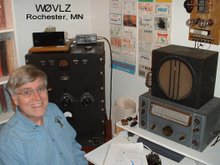Ross Hull's QST article documents a lot of experimentation done to understand the behavior of self-excited oscillators. Whether Hartley, Colpitts, TPTG or TNT Hull concluded that all of them behave about the same and the same tuning guidelines apply to all of them. In summary, any self-excited oscillator should be run at only about half power in order to produce at acceptable signal.
After the transmitter is on frequency and running at full plate voltage:
1) Tighten the antenna coupling as much as possible. In the case of my transmitter this meant moving the antenna coil until it almost touched the tuning coil. At maximum antenna coupling tune antenna loading for maximum output and note this "maximum output".
2) Back off antenna coupling to 75% maximum power (watts) or 85% output current (RF Amps) retuning antenna loading along the way.
3) Once you are at 75% power (or 85% RF current) output, detune antenna loading by adding capacitance to reduce output another 75% power (or 85% RF current). After detuning check your signal. In some cases Hull found that detuning antenna loading worked best if capacitance was reduced rather than added.
Hull plotted frequency vs load capacitance. His curves show a fairly steep curve around resonance and then they flatten out. When a self-excited oscillator is peaked up for maximum output any changes in antenna loading will have a maximum impact on frequency. At this tuneup point an antenna swaying in the wind (changing the load that the transmitter sees) will have a maximum impact on the signal frequency. Detuning the output the oscillator away from peak output moves the operating point to the flatter part of the frequency vs load capacitance curve. Antenna sway will have less impact.
Monday, November 16, 2009
Subscribe to:
Post Comments (Atom)

No comments:
Post a Comment